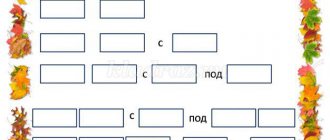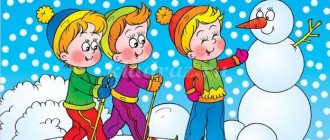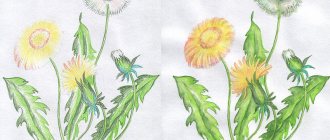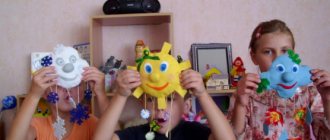Summary of an autumn walk in the senior group of kindergarten
Summary of a walk in the senior group on the topic: “Autumn”
Purpose: - Organize children’s recreation. Objectives: - To consolidate children’s knowledge about the changes that occur with trees in the autumn; — To consolidate children’s knowledge about trees and leaves, to enrich children’s vocabulary; — Exercise children in running, develop endurance (start running only after finishing the words); — Form in children the habit of maintaining cleanliness and order in the kindergarten area, the desire to work for the common benefit. Equipment: Children's rakes, brooms, buckets. 1. Introductory part: While walking, I ask the children a riddle: Leaves fly off the branches, Birds fly away to the south.
“What time of year is it?” - we’ll ask. They will answer us: “This is...” (autumn) - Guys, what time of year is it now? What month? (autumn, September) - How many autumn months are there? What are their names? (Three: September, October and November) - What autumn signs do you know? (cold days have arrived, it has become windy, it rains often; the leaves on the trees change color from green to yellow, orange, red, crimson; leaves are falling; insects are hiding; migratory birds are flying south; the nights have become longer and the days are short; people harvest from the fields, vegetable gardens and orchards; you need to dress warmly when you go outside, because it has become cold; the new school year has begun, the children began to go to school). — Who loves autumn and who doesn’t? Why? (children's answers) 2. Main part:
2.1.
Observing trees in autumn. I read the poem: Leaf fall, leaf fall, Yellow leaves are flying. Yellow maple, yellow beech, Yellow circle of the sun in the sky. Yellow yard, yellow house. The whole earth is yellow all around. Yellowness, yellowness, So autumn is not spring. V. Nirovich I ask the children questions: - How do trees change with the onset of autumn? —Have all the trees changed? — What is the name of the phenomenon: “falling of autumn leaves”? — What happened to the leaves? Has their color changed? — What colors are autumn leaves? Why do they change their color? I listen to the children's answers. 2.2. Individual work. I’m conducting a didactic game “Which tree did the leaf fall from?” » From oak - ... oak, From linden - ... linden, From rowan - ... rowan, From poplar - ... poplar, From aspen - ... aspen, From maple - ... maple, From birch - ... birch, From alder - ... alder. I praise children for correct answers. Didactic game “Find an extra word in each chain”, justify your choice: - spruce, rowan, tulip, maple; - poplar, birch, rose hips, oak; - rowan, apple, bird cherry, currant; - oak, aspen, spruce, linden. 2.3. Outdoor game “Burn, burn clearly” Contents of the game: I help the children stand in pairs and say the following words: Burn, burn clearly, So that it doesn’t go out Look at the sky - the birds are flying, The bells are ringing: 1, 2, 3 - run. The child runs between the pairs, chooses anyone, takes them by the hand and stands at the end of the pairs. Game continues. 2.4. Work “Cleaning leaves in a group plot.” With a subgroup of children we go to the part of the site where we will clean. I distribute rakes, brooms, and buckets to the children. To arouse interest in the upcoming activity, I use artistic words: - “Labor adorns a person”, - “Without labor there is no good”, - “Play is play, but business is business.” As work progresses, I organize and correct the children, give instructions, and monitor the quality of performance. At the end of the work, I praise the children for their efforts and ask them to assemble the equipment. 3. Final part. End of the walk. I call the children together and ask: “Guys, what did we observe today?” - What games did you play? What interesting things did you remember? I listen to the children's answers and praise them for their good work. After which I line up the children in pairs and lead them to the group.
We recommend watching:
Synopsis of a physical education lesson with children of senior preschool age Synopsis of a game lesson on the topic: Autumn for children of the senior group Synopsis of autumn leisure in a senior speech therapy group Scenario of autumn entertainment in a senior speech therapy group
Similar articles:
Summary of a lesson in the senior group on the topic “Animals in the forest in autumn”
Lesson summary on the topic “Autumn” in the senior group
Lesson on getting to know your surroundings in the senior group on an autumn theme
Walking in the senior group. Card file with goals for September
Walking in the senior group. Card index with goals for October
Summary of an autumn walk in the senior group. "Golden Autumn"
Summary of an autumn walk in the senior group. "Golden Autumn"
Target:
Summarize and systematize children’s knowledge about autumn (reinforce the concepts: early, golden, late);
Continue to get acquainted with rowan, highlighting the characteristic features and changes associated with the time of year;
To consolidate children's knowledge about the work of adults in the fall. Develop knowledge of educational activities: the ability to logically answer questions posed, prove your point. Cultivate a love for nature and respect for it.
Accustom children to hard work, instill hard work and a desire to help others. Develop mobility
Develop dexterity when performing movements, speed, endurance;
Progress of the walk
1. Observation.
Educator:
Guys, look what a wonderful day it is today, come closer to me. I'll tell you a riddle:
If the leaves on the trees have turned yellow,
If the birds flew to a distant land,
If the sky is gloomy, if it rains,
What is this time of year called? (autumn).
Educator:
Yes, it's autumn. Who will tell a poem about autumn (children recite familiar poems)
Educator:
Guys, what signs of autumn do you know? (It has become cold, the leaves turn yellow and fall off, it rains often, there are frosts in the mornings, the days are getting shorter, the nights are longer, insects and animals are preparing for winter)
Educator:
Yes, autumn is a time of year when all nature changes. The days are getting shorter, the sun is not warming up, it is getting colder day by day, and it rains often. By the end of autumn there will be frosts. Migratory birds fly south, wintering birds move closer to people.
Educator:
Guys, what do you think the weather is like today?
(Clear). Why? (The sun is shining brightly, there is no rain)
Let's take a breath of fresh, autumn air (breathing exercise).
Educator:
Guys, look at the colorful carpet that covers the earth. What kind of carpet is this? (Autumn fallen leaves)
Let's take the leaves in our hands, what do they feel like? (dry, rough, rustling)
How do the leaves rustle? (sh-sh-sh-sh-sh)
- Yes, the leaves flew off all the trees, and beautiful berries remained on one tree:
Autumn has come to our garden, lit a red torch, here blackbirds have been scurrying around since the morning, and, chattering, they peck at it.
(Rowan)
The teacher leads the children to a familiar rowan tree.
— What changes have happened to rowan? ( The leaves flew off, but the clusters of berries remained hanging.)
- Guys, look what we see on the ground? Where did the berries come from? (They were dropped by birds).
- What birds do you think visited our rowan tree?
Rowan is a favorite delicacy of blackbirds. They are called “Rowan Thrushes”. It can be seen that the blackbirds plucked the rowan berries hastily, leaving many scraps on the brushes. (If you manage to be sure to watch the birds pecking the rowan berries). In addition to blackbirds, other birds also love rowan. For example, waxwings. This beautiful bird is also called krasava. For thrushes and waxwings, rowan is a feeder.
2. Game “Migration of Birds”.
At one end of the site there are children (they are birds). At the other end there are aids on which you can “fly up” (gymnastic benches, cubes, etc.) - these are trees.
At the teacher’s signal: “The birds are flying away,” the children, flapping their arms like wings, scatter throughout the entire area. At the next signal “Storm” - they run to the heights and hide there from the driver - the “bird of prey”. At the signal “The storm has stopped,” they scatter around the area again.
3. Labor activity.
Educator:
Yes, in the fall you can often see leaves falling, what is this phenomenon called? (leaf fall)
There were a lot of leaf attacks on our site. Let's see what trees they come from.
Didactic game “Which tree is the leaf from?”
After the game, the teacher is given an envelope with a letter.
Educator:
Guys, we received a letter. It's from Lesovich, let's read it.
"Dear Guys. I, Lesovichok, help nature prepare for winter. Please help me collect autumn leaves. I can't do it alone.
Lesovichok"
Educator:
Guys, can we help Lesovik clean up our area? (We'll help)
Let's distribute who will do what.
(Children are divided into groups to complete tasks. After completing the tasks, they suddenly find a basket of apples in the gazebo.)
Educator:
Guys, there's a basket of apples here, I wonder who it's from? Yes, this is from Lesovik. He thanks us for our help and treats us to autumn apples. In the group we will wash them and eat them.
Educator:
Well, guys, I think we did a great job, collected autumn leaves, hung feeders, and removed all the garbage.
Now is the time to relax and play your favorite games
Children's games with take-out material based on their interests.
4.Individual work:
“What wind?”
Goal: expand vocabulary; consolidate the pronunciation of sound (c).
5. Independent play activities for children with external equipment:
Organization of creative games “Family”, “Sailors”.
Goal: to teach children to independently agree on the game and distribute roles.
After the game, the children enter the kindergarten.
Autumn walk - observation in kindergarten with older children
Summary of the autumn walk “Autumn, autumn we invite you to visit us” for children 5–6 years old
Author: Marina Viktorovna Vitskova, teacher of the MBDOU “Kindergarten “Golden Fish” of the Astrakhan region, Chernoyarsk district.
Description: Using this material, children develop observation, curiosity, and attention. This material will be useful for parents and kindergarten teachers when conducting autumn walks for older children. Goals: Continue to introduce children to plants in the kindergarten; learn to identify changes associated with the change of season; develop observation skills, search and research activities; form communicative relationships with peers during joint play and work activities. Types of activities: educational and research, gaming, communication, self-service, basic household work. Materials: buckets, rakes, brooms, shovels, containers, fox hat.
Organized structure of a walk
Observations of nature and its seasonal changes. Educator. Children guess the riddle. Mystery. In the morning we go into the yard - The leaves are falling like rain, rustling under our feet and flying, flying, flying. Children. It's autumn Educator. Well done, you guys are right. What autumn months do you know? Children. September October November. Educator. September is the first autumn month, the end of the harvest of vegetables and fruits. Guys, name the vegetables and fruits. Children's answers. Educator. Well done, right. Tell me, what color is the vegetation (trees, bushes) in autumn? What color are the leaves on trees and bushes? Name the plants, trees and bushes that grow on our site? Children's answers. Educator. Well done boys. Each tree has its own fall foliage color. Birch leaves turn yellow-golden in autumn. The leaves of willow and poplar are turning yellow. Rowan leaves turn red in autumn. Maple leaves turn red, but can also turn yellow and orange. Educator. Guys, now listen to the poems. In the autumn garden by the path, Aspen claps his hands. That's why Her palms turned red that week. The oak tree is not afraid of rain and wind at all. Who said that oak is afraid of catching a cold? After all, until late autumn I remain green. This means I am hardy, this means I am hardened. Poplar - everyone knows it - a champion in growth. And it’s not at all easy for you to get the top of my head, Because I grow two meters over the summer. The birch tree is thin and delicate and put on a snow-white dress, and the autumn sun dyed its braids yellow. This is how I greet the arrival of autumn every year. Educator. Now listen to the riddles and try to guess them. Riddles Leaves are spinning in the air, Quietly lying on the grass.
The garden is shedding its leaves - It’s just... (leaf fall) The wind will call a cloud, The cloud will float across the sky. And over the gardens and groves there is a cold drizzle... (rain) It has become gloomy outside the window, the rain is asking to come into our house. The house is dry, but outside Appeared everywhere... (puddles) In the gray sky, low Clouds move close, Closing the horizon. It will be raining. We took... (umbrella) An outdoor game is being played: It’s raining, it’s not raining!”
The leading “Rain” is selected - a trap.
All the children and the trap walk in a circle and say the words: “How many rains have I known? Count quickly, Rain with the wind, Rain with mushrooms, Rain with a rainbow-arc, Rain with the sun, Rain with hail, Rain with red leaves! After these words, all the children and the trap run around the entire hall (area). As soon as the teacher says: “Rain!” - everyone runs away from the trap and tries to climb onto some elevation (bench, cube, stump, etc.). The trap tries to catch the escaping people before they have time to stand on the high ground. Children touched by the trap step aside. At the end of the game, the number of caught players is counted and another driver is chosen. The game resumes. Research activities. Digging flowers from a flowerbed into a container for growing in a group.
Teach children to set work orders.
Help the kids clean the area.
Game activity.
Outdoor game: “Fox in the chicken coop” Purpose
: learn to jump gently, bending your knees; run without touching each other, dodge the catcher. Progress of the game: A “chicken coop” is outlined on one side of the site. In it, “chickens” sit on a roost (on benches). On the opposite side of the site there is a fox hole. The rest of the place is a yard. One of the players is designated as a “fox”, the rest are designated as “chickens”. At a signal, the “chickens” jump from their roost, walk and run around the yard, peck at grains, and flap their wings. On the signal: “Fox!” - the “chickens” run into the chicken coop and climb onto the roost, and the “fox” tries to drag away the “chicken”, who did not have time to escape, and takes her to her hole. The remaining "chickens" jump off the roost again and the game resumes.
Summary of the walk.
Educator. Children, did you enjoy the walk? Children. Yes! Educator. What did you like most and why? Children's answers.
We recommend watching:
Summary of an autumn walk in the senior group Autumn excursion to the forest with preschoolers of the senior group. Abstract from the experience of working as a kindergarten teacher. Autumn walk Autumn walk in the senior group “What autumn gave us”
Similar articles:
Walking in the senior group. Card index with goals for October
Walking in the senior group. Card index with goals for November
Autumn walk “Watching the sky” in the senior group
Autumn walk “Watching the rain.” Senior group
Card index of walks in the junior group according to the Federal State Educational Standard. September
Summary of a targeted walk in the senior group of kindergarten on the topic: Autumn
Targeted walk in kindergarten for children of senior preschool age “Autumn has come to visit us.”
Educational areas: “Cognitive development”, “Speech development”. Program objectives: - Update, systematize and supplement children’s knowledge about the phenomena characteristic of autumn; — To develop the ability to carry out comparative observation, to identify during it changes that have occurred with natural objects; — Learn to use the skills of solving riddles containing a description of the changes that occurred with natural objects in the fall; - Activate in speech and clarify the concepts of “portrait”, “landscape”, vocabulary associated with the nature of the walk. Technologies : gaming, search-research, health-saving, personality-oriented.
Equipment and materials: character - Autumn (doll or adult role), riddle texts, notebook for sketching the plan and results of the work, colored pencils. Progress of educational activities.
Motivational-oriented stage Conversation “Mysterious Guest” Teacher : Guys, you know, an unusual guest came to us today, look around, do you see her? (Children's answers) Teacher : Why don't you see? But our guest has come to our region for a long time. Tell me, please, what changes have occurred in nature? (The air temperature, the color of leaves and grass changed, insects were no longer visible, birds flew to warmer climes). Teacher : To find out the name of our guest we need to guess the riddle, are you ready to listen carefully to the riddle? (Children's answers) If the leaves on the trees have turned yellow, If the birds have flown to a distant land, If the sky is frowning, if the rain is pouring, What is this time of year, tell me, called? (Autumn) Teacher : So, who are we expecting to visit? (Autumn) That's right - Autumn. The arrival of Autumn confirms the correctness of the children’s answers. Autumn : Hello guys. I've wanted to meet you for so long. I'm very glad that you guessed who I am! I only visit once a year. I'm coming for the hot summer. Before the white winter. Will you make friends with me? Children respond to the guest and get to know her. Teacher: Guys, can you tell me what colors Autumn uses to recolor the leaves of the trees. Look what color the leaves of birch, oak, aspen, maple, chestnut have become, and what color is the grass? (Children's answers) You are great, very observant, you noticed all the colors of autumn, and you know how they affectionately say about our guest: A beautiful sorceress came, She repainted the foliage without paint. Autumn: And not just foliage! Everything around is about to change in the fall, and everything changes every day! That is why I would like to ask you to draw my portrait, to capture Autumn as it looks today. Do you agree to draw my portrait? The children’s agreement to fulfill the guest’s request determines the goal of the upcoming work: to draw a “portrait” of autumn. Search stage Conversation “How to help a bunny?”
The teacher organizes a discussion: what could be a “portrait” of autumn, leading the children to the conclusion that they should get a landscape.
It is also discussed what needs to be done to fulfill the guest’s request, to make a plan: 1. During the walk, identify the characteristic signs of autumn. 2. Get acquainted with the works of artists, poets and composers about autumn. 3. Draw pictures on the theme “Autumn”, organize an exhibition. Practical stage Children say goodbye to the guest and begin to implement the plan. Comparative observation “Signs of autumn”. Game - competition “Who is bigger?” Assignment:
Children are invited to join teams of 4 to 5 people and try to find as many signs of the arrival of autumn in their area as possible.
The winning team is revealed. To ensure a situation of success for all teams, it is necessary to allocate a corresponding number of nominations: - who will find more autumn transformations; - who will tell you more interesting about them; - who will find the most unusual transformations; - who will complete the task faster; - the friendliest team, etc. When organizing the work, it is important to emphasize that all the information collected by the children will be used by them when creating a “portrait” of autumn. That is why the results of observation and play are sketched and photographed. Didactic game “Find the answer” Task : Continuing to act in teams, children need to solve riddles about autumn transformations and find clues on the site. Examples of riddles:
He falls from a branch into a puddle and does not sink, but floats.
(Leaf) They grow - they turn green, They fall - they turn yellow, They lie down - they turn black. (Leaves) Flies without wings and sings, bullying passers-by. He doesn’t allow some people to pass, but he urges others on. (Wind) Red, yellow leaves curl and fly in the wind, The city is clear and clean, In our area... (Leaf fall) Autumn has come to our garden, The red torch has been lit. Here blackbirds and starlings scurry about and make noise and peck at him. (Rowan berries) While it was small, it did not fall, but as it grew, it fell. Isn't it funny? (Apple) The teacher helps the children come up with and draw the signs of the onset of autumn that they identified when solving riddles. Reflective-evaluative stage Collective story “Verbal portrait
” Children are invited to draw up a verbal portrait of autumn based on the results of their work encrypted in the drawings. The teacher draws the children’s attention to the work plan, organizes a discussion of what has been done and what remains to be done. The teacher invites the children to visit the music and literature lounge and prepare a performance. Follow-up work. Further implementation of the plan drawn up by the teacher with the children is carried out within the framework of the work of the musical and literary lounge.
We recommend watching:
Summary of an autumn walk with children of the middle - senior group of kindergarten Summary of a lesson on speech development in the senior group on the topic: Autumn Summary of a walk to the park with children of the senior group. Outline of an autumn walk in the senior group
Similar articles:
Autumn walk “Watching the sun”. Senior group
Autumn walk in the senior group. Introduction to the work of a janitor in a preschool educational institution
Autumn walk in kindergarten in the senior group. Withered plants
Lesson summary - traveling in kindergarten for the International Day for Older Persons
Entertainment “Visiting Autumn”. Senior group



